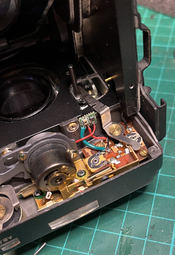Hi,
Out of boredom and pursuit of perfection, I have manufactured a small batch of 1.35V and 2.7V voltage regulators. The reason is simple: I wanted to solder them into my cameras and meters, so that I can use any batteries I can buy (up to 5V). Minimum order quantity made me order 10x more than needed. I also thought that the CRIS adapter is way overpriced for what it is. Here, the output is always stable 1.35V or 2.7V, regardless of current draw, temperature, etc. Which is not the case with Schottke diodes. Size is miniature, 6x6mm. I called it "stable625" and posted on well-known auction website.
I have received mixed reactions in facebook groups - some were very positive, some were quite the contrary.
Here I present a sample installation in my Yashica 124G TLR. There are 2 ways to do it, one is in the side compartment, the easier one is by the light meter. This camera uses switching by ground. I also added it to Gossen Lunapro and Sekonic L-136.
The flaw of this solution is obvious: there is a quiescent current, very small circa 20uA, but I haven't tested the battery drain. My rough calculations would put a SR44 coin cell in range of 2 months. That's why so far I've used devices with some kind of switch between the battery and the electronic circuit. Regarding Gossen Lunapro, I have to keep the batteries out when not used. Not a big deal.
Let me know what you think!
Best regards
Out of boredom and pursuit of perfection, I have manufactured a small batch of 1.35V and 2.7V voltage regulators. The reason is simple: I wanted to solder them into my cameras and meters, so that I can use any batteries I can buy (up to 5V). Minimum order quantity made me order 10x more than needed. I also thought that the CRIS adapter is way overpriced for what it is. Here, the output is always stable 1.35V or 2.7V, regardless of current draw, temperature, etc. Which is not the case with Schottke diodes. Size is miniature, 6x6mm. I called it "stable625" and posted on well-known auction website.
I have received mixed reactions in facebook groups - some were very positive, some were quite the contrary.
Here I present a sample installation in my Yashica 124G TLR. There are 2 ways to do it, one is in the side compartment, the easier one is by the light meter. This camera uses switching by ground. I also added it to Gossen Lunapro and Sekonic L-136.
The flaw of this solution is obvious: there is a quiescent current, very small circa 20uA, but I haven't tested the battery drain. My rough calculations would put a SR44 coin cell in range of 2 months. That's why so far I've used devices with some kind of switch between the battery and the electronic circuit. Regarding Gossen Lunapro, I have to keep the batteries out when not used. Not a big deal.
Let me know what you think!
Best regards





